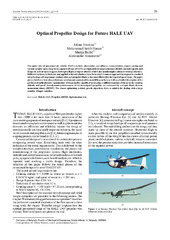Приказ основних података о документу
Dizajn optimalne elise za buduću bespilotnu letelicu za velike visine i duge istrajnosti
Optimal Propeller design for future HALE UAV
| dc.creator | Svorcan, Jelena | |
| dc.creator | Hasan, Sakib Mohammad | |
| dc.creator | Baltić, Marija | |
| dc.creator | Simonović, Aleksandar | |
| dc.date.accessioned | 2022-09-19T18:47:42Z | |
| dc.date.available | 2022-09-19T18:47:42Z | |
| dc.date.issued | 2019 | |
| dc.identifier.issn | 1820-0206 | |
| dc.identifier.uri | https://machinery.mas.bg.ac.rs/handle/123456789/3120 | |
| dc.description.abstract | Osnovne uloge bespilotnih letelica podrazumevaju: osmatranje, nadzor, prenos robe, daljinsko očitavanje i različite bezbedonosne zadatke. Poboljšana klasa bespilotnih letelica su one koje su posebno projektovane za velike visine leta i duge istrajnosti (uglavnom pri podzvučnim brzinama krstarenja). Do sada je probano nekoliko varijanti koje se razlikuju kako po dimenzijama tako i po primenjenim tehničkim rešenjima. Uobičajeni pristup podrazumeva standarnu konfiguraciju krilotrup-zadnje repne površine i let pomoću elise koja je najefikasnija u tom opsegu brzina. Rad ukratko prikazuje preliminarnu aerodinamičku analizu glavnih uzgonskih površina, ali i detaljniji opis izvedene višekriterijumske optimizacije elise sposobne da obezbedi dovoljni potisak na zadatoj visini i brzini krstarenja. Aerodinamičke performanse razmatranih elisa procenjene su kombinovanim modelom. Izabrani optimizacioni metod, genetski algoritam, pogodan je za probleme koji uključuju veliki broj ulaznih promenljivih. | sr |
| dc.description.abstract | The main roles of unmanned air vehicles (UAVs) include: observation, surveillance, transportation, remote sensing and various security tasks. Improved, augmented type of UAVs are high-altitude long-endurance (HALE) aircraft capable and designed, as their name suggests, for lengthy flights at higher altitudes (which also usually implies subsonic cruising velocities). Different variants, in both size and applied technical solutions, have been tried. Common approach incorporates standard wing-fuselage-aft empennage configuration and propelled flight as the most efficient for the required speed range. The paper gives a brief overview of a preliminary aerodynamic analysis of the main lifting surfaces as well as a detailed description of the performed multi-objective optimization of the propeller capable of producing a sufficient amount of thrust at the cruising altitude and speed. Aerodynamic performances of the investigated propellers are estimated by a simple blade element momentum theory (BEMT). The chosen optimizing method, genetic algorithm (GA), is suitable for dealing with a large number of input variables. | en |
| dc.publisher | Vojnotehnički institut, Beograd | |
| dc.relation | info:eu-repo/grantAgreement/MESTD/Technological Development (TD or TR)/35035/RS// | |
| dc.rights | openAccess | |
| dc.rights.uri | https://creativecommons.org/licenses/by/4.0/ | |
| dc.source | Scientific Technical Review | |
| dc.subject | velika visina leta -duga istrajnost | sr |
| dc.subject | optimizacija | sr |
| dc.subject | kombinovana teorija | sr |
| dc.subject | genetski algoritam | sr |
| dc.subject | elisa | sr |
| dc.subject | bespilotna letelica | sr |
| dc.subject | UAV | en |
| dc.subject | propeller | en |
| dc.subject | optimization | en |
| dc.subject | HALE | en |
| dc.subject | GA | en |
| dc.subject | BEMT | en |
| dc.title | Dizajn optimalne elise za buduću bespilotnu letelicu za velike visine i duge istrajnosti | sr |
| dc.title | Optimal Propeller design for future HALE UAV | en |
| dc.type | article | |
| dc.rights.license | BY | |
| dc.citation.epage | 31 | |
| dc.citation.issue | 2 | |
| dc.citation.other | 69(2): 25-31 | |
| dc.citation.rank | M51 | |
| dc.citation.spage | 25 | |
| dc.citation.volume | 69 | |
| dc.identifier.doi | 10.5937/str1902025S | |
| dc.identifier.fulltext | http://machinery.mas.bg.ac.rs/bitstream/id/1783/3117.pdf | |
| dc.type.version | publishedVersion |


